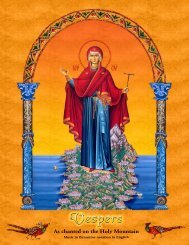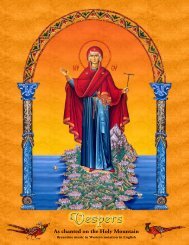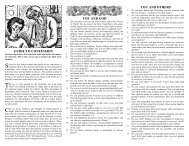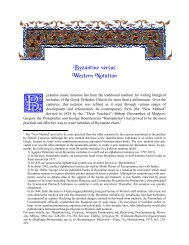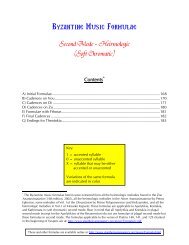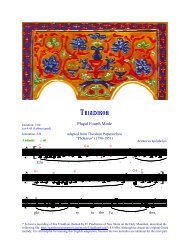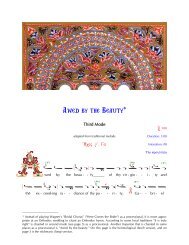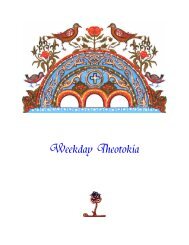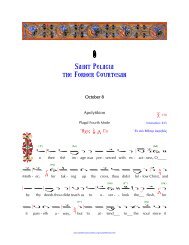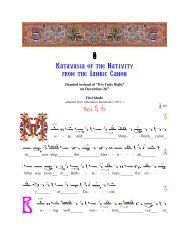Reading Psalmodia (PDF) - St. Anthony's Monastery
Reading Psalmodia (PDF) - St. Anthony's Monastery
Reading Psalmodia (PDF) - St. Anthony's Monastery
You also want an ePaper? Increase the reach of your titles
YUMPU automatically turns print PDFs into web optimized ePapers that Google loves.
MODES: The Mode in which Irmic melodies are sung is the Diatonic scale on D/Pa:Pa [10] Vu [8] Ga [12] Di [12] Ke [10] Zo [8] Ni [12] PaUsually, however, the note Zo is flattened in both descending phrases and in phraseswhich ascend to it but do not immediately proceed to the Ni’ or Pa’ above. Many Psaltaifollow a somewhat dubious Thessalonikan fashion and flatten Vu in descent as well.Exceptionally, the melody Ton Taphon Sou Sōtēr is sung to a chromatic mode; usually it issung in the soft chromatic scale, but some modern versions offer a related melody in ahard chromatic mode. Since it belongs to the Tone One Anastasimatarion, the melody issaid to be in Tone I Chromatic; it could equally be assigned musically to Tone II.<strong>St</strong>icheric melodies are sung to a mode which uses the same scale, but which usesdifferent melodic loci and cadences.TONE TWO:Scale Type: CHROMATIC.Basic Note: Irmic melodies: Pa<strong>St</strong>icheric melodies: Di , sometimes BouDominant Notes: Irmic Melodies: Pa, Di<strong>St</strong>icheric Melodies: Ni, Bou & DiMODES: The Irmic melodies of Tone Two are normally sung to a mode based on theHard Chromatic scale, with Pa as its basic note. <strong>St</strong>icheric melodies are sung to a modewhich uses the Soft Chromatic scale, with Di as its basic note. Some Pappadic melodiesuse a mode based on the Soft Chromatic scale with Vu as its basic note.The use of two modes, one based on the hard chromatic scale, one on the soft chromaticscale is also found in the Plagal Second Tone.The second tone is very widely used in <strong>Psalmodia</strong>. It is the Tone commonly used for theEkfonesis, the Antiphons and the Trisagion of the Divine Liturgy. Correctly, Tone IIshould be used for all the main melodies of the Synaxis, but in contemporary practiseTone V and Tone VIII are commonly used. [The XIXth century composer Chaviara wassolemnly condemned by the Ecumenical Patriarch for having the Divine Liturgy sung in VIII.]TONE THREE.Scale Type: ENHARMONICBasic Note: GaDominant Notes: Pa, Ga & KeMODES: Both Irmic and <strong>St</strong>icheric melodies are constructed in modes which use theenharmonic scale on Ga. In practice some singers do not make a clear systematicdistinction between the scale on which they sing Tone III and the scale they use to singTone VIII melodies based on Ga. The sharper Vu of Tone III is, however, important forthe colouring it gives.TONE FOURScale Type: DIATONIC and CHROMATICBasic Note: Irmic & Short <strong>St</strong>icheric BouSlow <strong>St</strong>ichericPa



